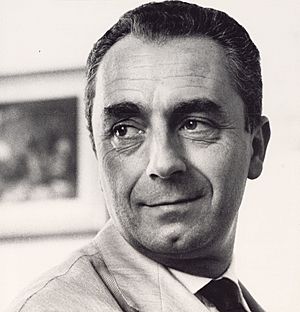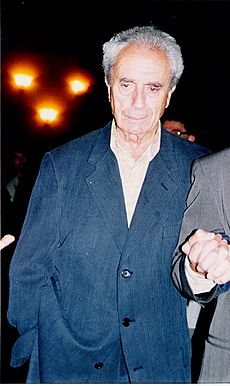Michelangelo Antonioni facts for kids
Quick facts for kids
Michelangelo Antonioni
|
|
|---|---|
 |
|
| Born | 29 September 1912 |
| Died | 30 July 2007 (aged 94) Rome, Italy
|
| Alma mater | University of Bologna |
| Occupation |
|
| Years active | 1942–2004 |
|
Notable work
|
|
| Spouse(s) |
Letizia Balboni
(m. 1942; div. 1954)Enrica Fico
(m. 1986) |
| Partner(s) | Monica Vitti (1960–1970) |
Michelangelo Antonioni (born September 29, 1912 – died July 30, 2007) was a famous Italian director and filmmaker. He was known for making movies that explored how people felt in the modern world. His most famous films include L'Avventura (1960), La Notte (1961), L'Eclisse (1962), and Blow-up (1966).
His films often had deep meanings and beautiful visuals. They focused on how people felt alone or disconnected in busy cities. Antonioni's work greatly influenced other filmmakers. He won many important awards, including the Palme d'Or, the Golden Lion, the Golden Bear, and the Golden Leopard. He is the only director to have won all four of these major awards.
Contents
Early Life and Education
Michelangelo Antonioni was born in Ferrara, Italy. His family was wealthy and owned land. As a child, he loved drawing and music. He was a talented violinist and gave his first concert at age nine. Even though he stopped playing the violin when he discovered movies, drawing remained a passion throughout his life.
He once said that as a child, he loved to draw houses and gates. He would create imaginary towns with tiny figures and invent stories for them. He felt these childhood games were like making small films.
Antonioni studied economics at the University of Bologna. After graduating in 1935, he started writing about films for a local newspaper called Il Corriere Padano.
In 1940, he moved to Rome. He briefly worked for a film magazine and then studied film techniques. He also served in the army during World War II.
Antonioni's Film Career
Starting Out in Film
In 1942, Antonioni began his film career. He helped write a film called A Pilot Returns and worked as an assistant director. He then went to France to assist another director.
He started making short films, like Gente del Po (1943). This film was about the lives of poor fishermen. These early films were like documentaries, showing the everyday lives of ordinary people. This style was part of a movement called Italian neorealism.
However, Antonioni's first full-length movie, Cronaca di un amore (1950), was different. It focused on the lives of middle-class people. He continued this theme in films like I vinti (1952), which told stories about young people getting into trouble in different countries. Other films like La signora senza camelie (1953) and Le amiche (1955) also explored the lives of middle-class women.
His film Il grido (1957) returned to working-class stories. Many of these early films explored the idea of people feeling alone or disconnected from society.
Gaining International Fame
In Le Amiche (1955), Antonioni started using a new filmmaking style. Instead of a simple story, he showed events that seemed unconnected. He also used long takes, which are scenes filmed for a long time without cutting.
He used these techniques again in L'avventura (1960), which became his first big international success. It was shown at the Cannes Film Festival and became popular in art house cinemas worldwide.
He followed this with La notte (1961) and L'Eclisse (1962). These three films are often called a "trilogy" because they share a similar style and theme: people feeling lost in the modern world. La notte won the Golden Bear award at the 11th Berlin International Film Festival.
His first color film, Il deserto rosso (The Red Desert, 1964), also explored similar themes. It is sometimes seen as the fourth film in this group. All these films starred Monica Vitti, who was his partner at the time.
Antonioni then made a deal to direct three English-language films for MGM. The first was Blowup (1966), set in London. It was a huge international hit. The second film, Zabriskie Point (1970), was set in America and explored the counterculture of the 1960s. Its soundtrack featured music from famous bands like Pink Floyd and the Rolling Stones. However, this film was not very successful.
The third film, The Passenger (1975), starred Jack Nicholson. It received good reviews from critics but did not do well at the box office.
In 1972, Antonioni visited China and made a documentary called Chung Kuo, Cina. This film was not well-received by the Chinese government at the time. However, it was later shown in China in 2004 to honor Antonioni's work.
Later Works and Recognition
In 1980, Antonioni made Il mistero di Oberwald (The Mystery of Oberwald), experimenting with color using video technology. He also made Identificazione di una donna (Identification of a Woman, 1982), which returned to his earlier themes.
In 1985, Antonioni had a stroke, which affected his ability to move and speak. Despite this, he continued to make films. He directed Beyond the Clouds (1995) with help from director Wim Wenders. They won an award together at the Venice Film Festival.
In 1994, he received an Honorary Academy Award for his amazing visual style in cinema. Jack Nicholson presented him with the award. Antonioni's last film was a short segment in the movie Eros (2004), made when he was in his 90s.
Michelangelo Antonioni passed away on July 30, 2007, in Rome, at the age of 94. He was buried in his hometown of Ferrara.
Personal Life
Antonioni was married twice. His first marriage was to Letizia Balboni in 1942. Later, in 1986, he married Enrica Fico. He also had a significant relationship with actress Monica Vitti, who starred in many of his famous films like "L'avventura" and "La notte." Their relationship was very important for his creative work.
Antonioni was always dedicated to his filmmaking. He is remembered as one of the most important directors of the 20th century. He was known for his unique and artistic way of making movies.
Filmography
Feature films
| Year | English title | Original title |
|---|---|---|
| 1950 | Story of a Love Affair | Cronaca di un amore |
| 1953 | The Vanquished | I Vinti |
| 1953 | The Lady Without Camelias | La signora senza camelie |
| 1955 | The Girl Friends | Le Amiche |
| 1957 | The Cry | Il Grido |
| 1960 | The Adventure | L'Avventura |
| 1961 | The Night | La Notte |
| 1962 | The Eclipse | L'Eclisse |
| 1964 | Red Desert | Il Deserto Rosso |
| 1966 | Blowup | |
| 1970 | Zabriskie Point | |
| 1972 | Chung Kuo, Cina | documentary |
| 1975 | The Passenger | Professione: Reporter |
| 1980 | The Mystery of Oberwald | Il mistero di Oberwald |
| 1982 | Identification of a Woman | Identificazione di una donna |
| 1995 | Beyond the Clouds | Al di là delle nuvole |
Short films
- Gente del Po (People of the Po Valley, filmed in 1943, released in 1947) – 10 minutes
- N.U. (Dustmen, 1948) – 11 minutes
- Oltre l'oblio (1948)
- Roma-Montevideo (1948)
- Lies of Love (L'amorosa menzogna, 1949) – 10 minutes
- Sette canne, un vestito (Seven Reeds, One Suit, 1949) – 10 minutes
- Bomarzo (1949)
- Ragazze in bianco (Girls in White, 1949)
- Superstizione (Superstition, 1949) – 9 minutes
- La villa dei mostri (The House of Monsters, 1950) – 10 minutes
- La funivia del Faloria (The Funicular of Mount Faloria, 1950) – 10 minutes
- Tentato suicido (When Love Fails, 1953) – episode in L'amore in città (Love in the City)
- Il provino (1965) – episode in I tre volti
- Inserto girato a Lisca Bianca (1983) – 8 minutes
- Kumbha Mela (1989) – 18 minutes
- Roma (Rome, 1989) – episode in 12 registi per 12 città, for the 1990 FIFA World Cup
- Noto, Mandorli, Vulcano, Stromboli, Carnevale (Volcanoes and Carnival, 1993) – 8 minutes
- Sicilia (1997) – 9 minutes
- Lo sguardo di Michelangelo (The Gaze of Michelangelo, 2004) – 15 minutes
- Il filo pericoloso delle cose (The Dangerous Thread of Things, 2004) – episode in Eros
Awards and Honors
Michelangelo Antonioni received many important awards throughout his career:
- Academy Honorary Award (1995)
- Berlin International Film Festival Golden Bear (1961), for La Notte
- Cannes Film Festival Jury Prize (1960), for L'Avventura
- Cannes Film Festival Palme d'Or (1967), for Blowup
- David di Donatello Award for Best Director (1961), for La Notte
- European Film Awards Life Achievement Award (1993)
- Italian National Syndicate of Film Journalists Silver Ribbon for Best Director (1956), for Le Amiche
- Venice Film Festival Silver Lion (1955), for Le Amiche
- Venice Film Festival Golden Lion (1964), for Red Desert
- Venice Film Festival Career Golden Lion (1983)
See also
 In Spanish: Michelangelo Antonioni para niños
In Spanish: Michelangelo Antonioni para niños


